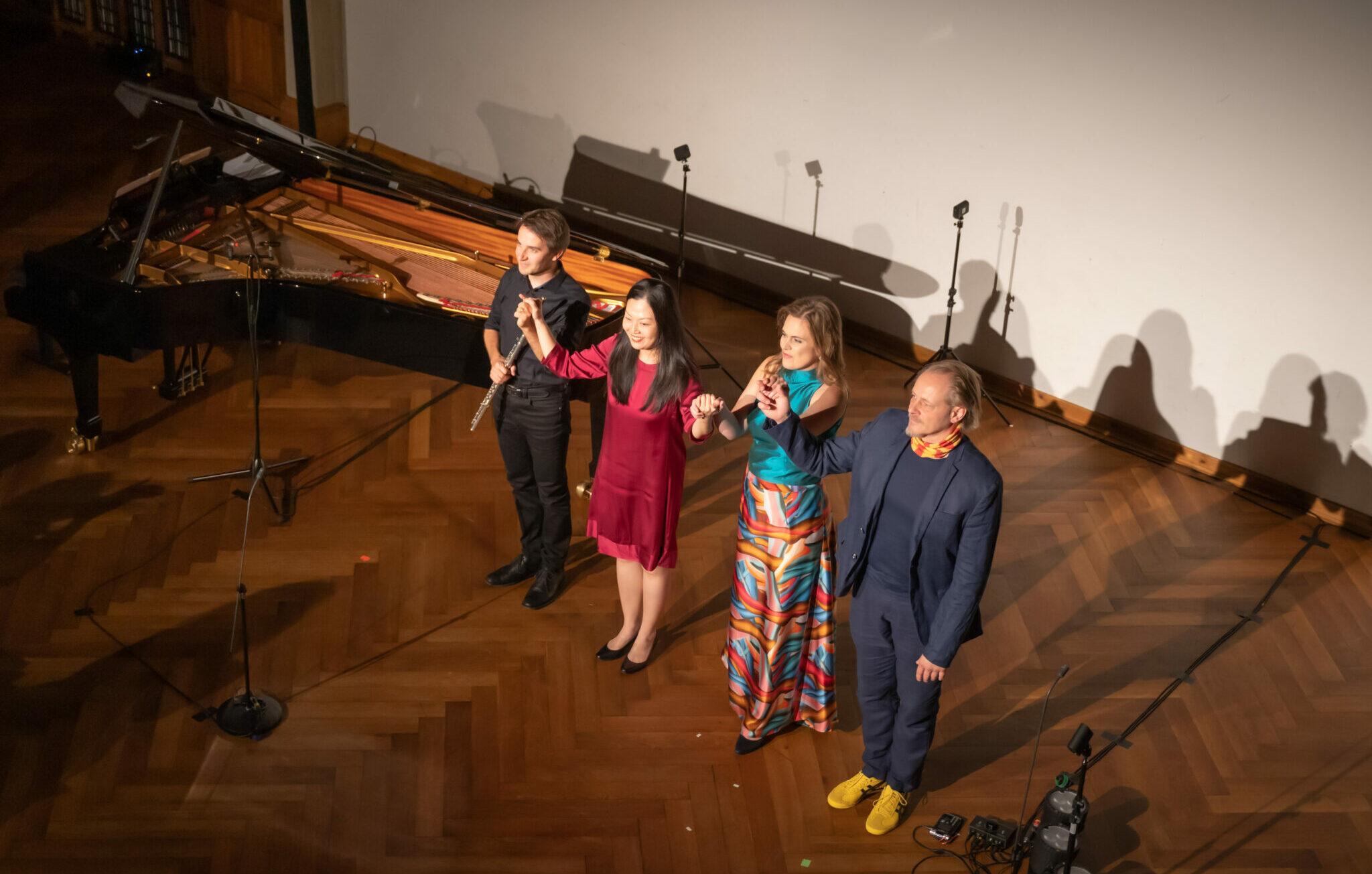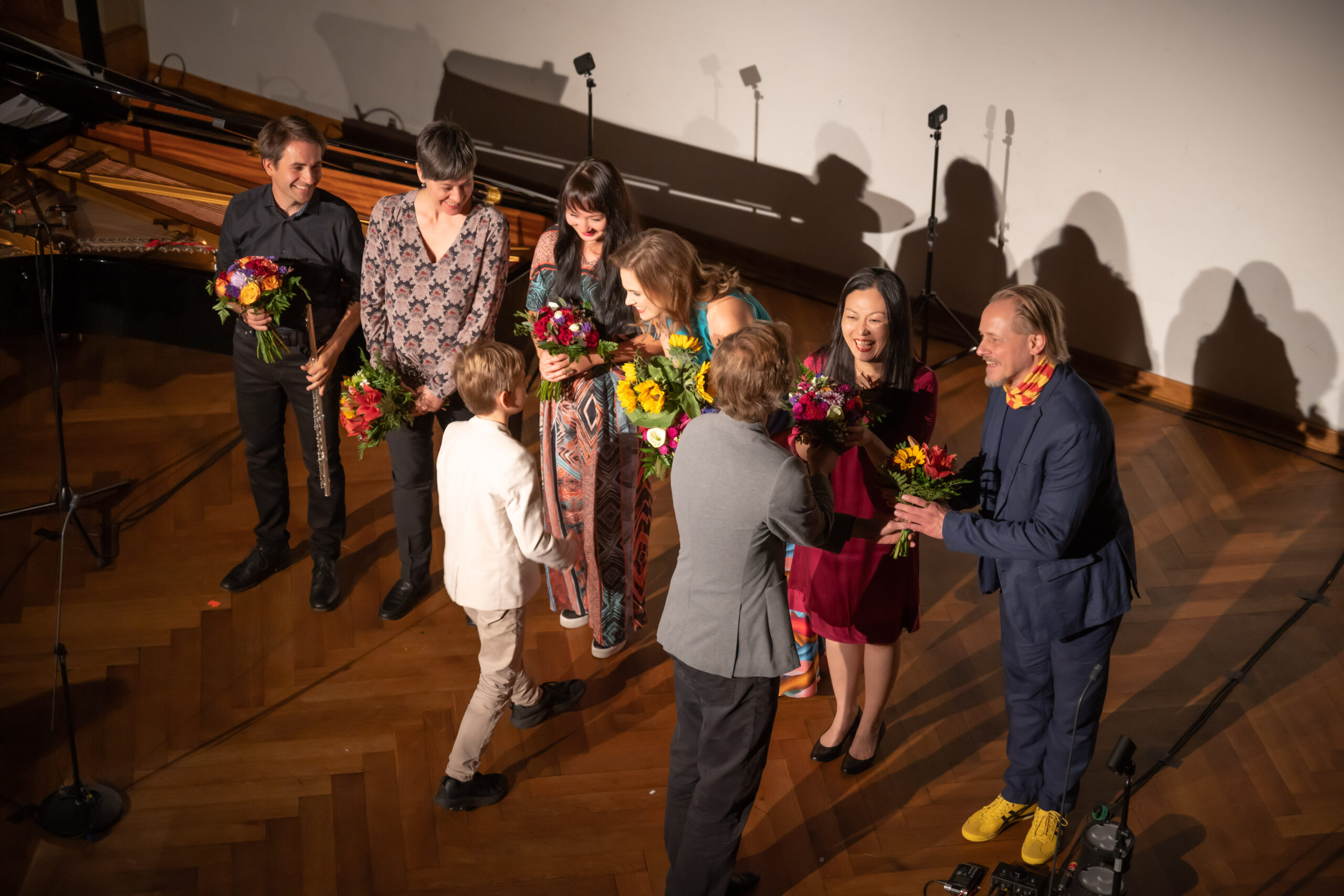Klári
Concerts for Voice, piano, video art
& guests
Sometimes you can see music - in the KLÁRI project, for example. In these unique concert programs, we use specially created video art to complement the music with another "voice". The films are thus given their own function and weave their own image in movement and color. Each one is different, following the respective composition. Together they grow into a strong, new work of art.
KLÁRI - the name of the project commemorates the lyricist Klára Gombossy. It was she who rescued Béla Bartók from his creative crisis, who gave him back the energy to compose - and who inspired him to write his cycle op. 15, with which our project began.
More video material on request at: info[at]klari.art
from the program Klári-Suite
GORECH! GORECH! von Peter Eötvös
Concerts for Voice, Piano, VideoArt
& Guests
Sometimes you can see music - in the KLÁRI project, for example. Because in these unique concert programs, video art is used as a separate voice alongside the music - it has its own function. Movement and colors weave their image, each in a different way, following the respective composition. Together they grow into a powerful work of art.
KLÁRI - the name of the project commemorates the lyricist Klára Gombossy. It was she who rescued Béla Bartók from his creative crisis, who gave him back the energy to compose - and who inspired him to write his cycle op. 15, with which our project began.
About us
.voice .concept
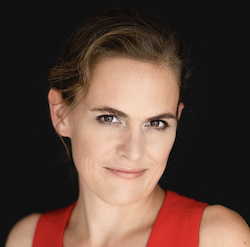
The musical training of Berlin-born Sarah van der Kemp is extraordinarily broad: Musicology and piano are part of it, but singing is most important to her. She studied at the Hanns Eisler Academy of Music in Berlin with the grande dame of her field: Professor Julia Varady. She holds a scholarship from the Richard Wagner Society and has also attended masterclasses with the most renowned greats of our time, such as Peter Konwitschny, Thomas Quasthoff and Rudolf Piernay. However, her closest collaboration was with Dietrich Fischer-Dieskau, with whom she developed a broad repertoire including works by Johannes Brahms, Franz Schubert, Hugo Wolf and the entire song repertoire of Gustav Mahler.
In her fixed engagements as a solo mezzo-soprano at the Deutsche Oper Berlin and the Staatstheater Schwerin, Sarah van der Kemp Kemp sang many of the most important roles in her field:Duke Bluebeard's Castle), Composer (Ariadne on Naxos), Rosina (Barbiere di Siviglia), Hänsel (Hänsel and Gretel), Carmen (Carmen), Fox (The Cunning Little Vixen), Eboli (Don Carlo), Sieglinde (Valkyrie) und viele mehr.
Further engagements have taken Sarah van der Kemp to the Shenzhen Philharmonic Orchestra in China, the Dresden Philharmonic, the Berlin State Opera, the Konzerthausorchester Berlin, the Festival d'Avignon, the Festival de Radio France in Montpellier, the Philharmonie Baden Baden and many other international festivals.
In concert, her special passion is the interpretation of orchestral songs. Her repertoire includes songs by Mahler, Wagner, Berlioz, Berg, de Falla and others.
Her own projects and conceptions broaden and deepen the singer's expressive spectrum - she has developed concert series and individual events in various dimensions and constellations, in the recent past for example a juxtaposition of Mahler's Song of the Earth with commissioned works for solo instruments by Peter Eötvös, Toshio Hosokawa and Nathan Currier.
.Video art
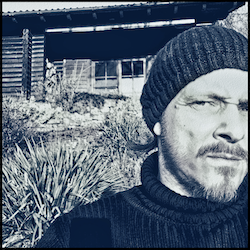
Robert Pflanz lives in Berlin and has his studio there.
Equipped with cameras and laptops, however, he works always and everywhere and sees himself as a hunter of the visual, whether concert, opera, dance, theatre or installation.
Robert, born and raised in the Ruhr area, began studying architecture there, at the same time gaining his first experience in the field of theatre design, and then went to Berlin to complete his main studies, first at the Weissensee School of Art, then at the University of the Arts (now the UdK). As a guest student at the Free University of Berlin, he intensively studied philosophical aspects of design. Finally, he completed a master's degree in stage design at the TU-Berlin.
As a central, highly paradoxical theme of his stage design, Robert Pflanz always states that he wants to make the world and worlds beside or behind the physical physically tangible.
On the other hand, Pflanz is a precise theatre practitioner who is also enthusiastic about clear structuring, the joining of elements. He experiences the artistic process as an essential part of the result.
In addition to his many years of experience as a freelance stage and costume designer, his focus since 2004 has been on video art.
He has worked at renowned theatres, opera houses and concert halls such as the Staatstheater Schwerin, the Komische Oper Berlin, the Staatsoper Unter den Linden, the Theater Schloss Maßbach, the Opernhaus Kiel, the Deutsche Oper Berlin, the Bad Hersfelder Festspiele, the Palacio de Bellas Artes in Mexico City, the Teatro Juárez in Guanajuato, the Staatstheater Cottbus, the Stadttheater Fürth, the Hamburg State Opera, the Michailowski Theatre in St. Petersburg, the Bavarian State Opera, the Mozarteum Foundation Salzburg, the Anhaltisches Theater Dessau, the Philharmonie Luxembourg, and many others. Petersburg, the Bavarian State Opera, the Mozarteum Foundation Salzburg, the Anhaltisches Theater Dessau, Philharmonie Luxembourg, and many more.
.management .equipment
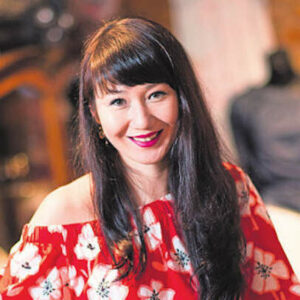
Some lives fit more than others - Saule Moldalukova's is one of those. Perhaps because her roots are so widely scattered: all over Central Asia.
Saule was born in Bishkek on the Silk Road. Since then, she has carried the desire to travel, the business sense, the preference for colours and the passion for good fabrics. She wanted to study fashion design as long as she could remember; she knew that clothes would determine her career ever since she could button her own skirt.
A breadless art, her father thought. So Saule studied international politics in Kyrgyzstan during the day - and learned to tailor the clothes she would like to wear herself in the evening. She completed both courses. A winding path led her to Istanbul, where she worked in project development for corporations, and later to a fashion company in Paris, from where she was sent to Berlin to open a store for the label in KaDeWe. Soon afterwards, the entrepreneur moved to her own boutique in Berlin Schöneberg.
Interview
Stefanie Schuster posed the questions
.How the project came about
Stefanie Schuster put the questions.
How the project came about
Some projects have to mature slowly until they have found their final format - like the Klári project. In an interview, Sarah van der Kemp explains how the lockdown helped her to develop her new music format.
Ms. van der Kemp, how did you get involved in the Klári project?
Two things came together. Firstly, the first pandemic lockdown had just started and the concerts were all canceled. I was looking for a different performance format so that I could still perform. And secondly, I wanted to perform Bartók's song cycle op. 15 - the Klári songs. I heard the songs for the first time a few years ago and they have stayed with me ever since. I was thrilled by the music and wondered why they are so rarely performed. I suppose it was because of the lyrics, which the critics thought were "bad". However, I didn't think that was the case at all and wanted to set a different tone with a new interpretation. This gave rise to the idea of making Bartók's songs the focus of a concert program and literally putting them in a different light. And because we were still in a pandemic, I also decided on a video format.
How did you find your colleague Robert Pflanz?
I knew Robert from an opera production in Schwerin. He did the stage design there and I sang. I was thrilled by his stage design and his video installations. It was used so sensitively and tastefully that I thought: either I do this with Robert or not at all. Of course, I didn't tell him that at the beginning!
What does the name "Klári project" stand for?
The name stands for the concert format, i.e. chamber music with video art, as well as for the ensemble. It recalls the origin of the project idea and the first program, the Klári-Suite. The namesake is Klára Gombossy, the very young poetess of the Bartók songs that started it all. The two met on one of Bartók's study trips, where Klára, the 14-year-old daughter of a forester, translated Slovakian folk songs for him. Bartók collected and archived these songs. Later, she also showed him her own texts. Bartók recognized Klára's talent and encouraged her education. We know that Béla Bartók fell in love with Klára Gombossy, but that she did not return his feelings. However, after a long creative crisis after the First World War, she seems to have encouraged him to compose again. What remains for us are the four settings of her poems in his cycle op. 15.
Why were you so interested in - and touched by - this little-known song cycle?
For me, these songs have a very unique and unusual quality. Bartók is known for collecting and writing down folk songs from a wide range of ethnic groups. Folk songs have the same melody and accompaniment in every verse. In Bartók's oeuvre there are only 10 so-called art songs, those in op. 15 and 16, which are characterized by the fact that they are through-composed, i.e. each verse has a different melody and also a different accompaniment in the piano. The music develops along the text as the song progresses. Bartók did not invent this principle, but it is an exception in his own oeuvre. In contrast to the folk songs he collected, they are musically and thematically very reminiscent of his opera "Bluebeard's Castle" - they are like a concert version in miniature!
What particularly touches me about the Klári songs is Bartók's treatment of the texts. They reflect the whole range of a young woman's longings - from erotic fantasies to the longed-for spiritual union of two souls, the formulation of which was certainly not common at the time. Bartók gives space to these passionate feelings, allows them to explode, and at the same time he restrains them through his musical form and sound world. I think he recognized these unreflected, free outbursts of emotion as a quality of particularly strong, passionate expression, and generously ignored the sometimes somewhat awkward poetry. This word-sound relationship is very appealing in interpretative work!
Do you need to know about this background to properly understand the songs and their realization?
No. The songs stand on their own. In this case, background knowledge is perhaps more of a hindrance when listening, because it quickly leads to speculation about the relationship between Klára and Bartók. The fact that she was only 14 years old, while Bartók was already in his late thirties and also married, apparently gives rise to many speculations, in which I do not wish to participate.
These plays are still rarely performed today - so are you breaking a taboo in your performances?
No. In the history of their reception, the lyrics of the songs are almost uniformly scathingly judged. They are dismissed as pubertal eroticism, embarrassing, amateurish and naive. For me, these assessments reveal more about the authors' relationship to erotic themes than about the quality of the poems. Longings for love are no longer taboo today!
Ms. van der Kemp - why does your music actually need video art as a backdrop?
I'm glad you asked! There is a danger of confusion when combining music and video, which I want to avoid at all costs. After all, this also concerns the question of artistic added value.
Videos in connection with classical music are nothing new, and are very fashionable at the moment. In chamber music, my singer's heart is actually completely against it. After all, songs and chamber music are all about depicting space and colors in sound. The images should arise spontaneously in the listener's mind - before their inner eye, completely individually. For me, that is art and its magic.
However, if you provide the images, such as in a video, the video can quickly become a substitute or even a duplication of the interpretative task. But that is not what we intend to do in our concert programs! The video should neither duplicate the music nor explain the words, and certainly not depict a scene like in an opera. The video art is used by us "purely compositionally". Quasi as our own musical voice that you can "hear".
The important, and perhaps also the unique thing about the KLÁRI idea is not that the video appears as a new instrument, i.e. as a new chamber music instrumentation, but that a musical-aesthetic standpoint is created. Form and content should correspond. And we extend this to the entire concert evening. The development of video art throughout the evening spans a wide artistic arc.
What is your artistic aim?
The process! The project is an experiment.
What was the biggest challenge in this unprecedented project?
The most difficult thing was to find a balance between image and music. Bartók's music, his songs, don't really need images, because they emerge by themselves when you listen to them. And from the perspective of a singer, I use video art to create a companion who is always faster than me.
For each song, we asked ourselves in which function the video could logically appear. Where does the music leave room? Where can the video appear without flooding the music? The answer is different for every work, which is really amazing.
And how did you set the topics?
In KLÁRI -SUITE, the theme is passion in various facets between creative and destructive forces that "expand" exponentially. I chose this theme because this movement reminds me strongly of a popular compositional principle by Bartók, which is also found in the Klári-songs already appears. He liked to use the proportions of the golden ratio or the Fibonacci number sequence in his works. And so the video shows this growth as a large arc over the entire evening. This makes it look like an enlargement of his compositional principle. The colors also play an important role: black and white + blurred develop into fast + colorful.
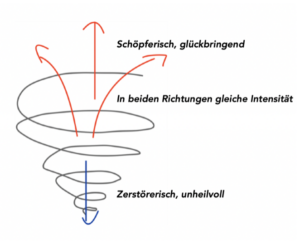
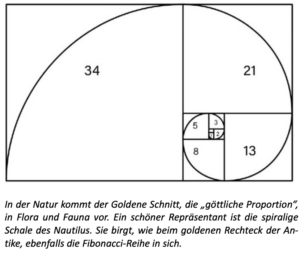
How does the audience react to your work? Can the audience understand it? Or do you have to give a special introduction?
First of all, we were all delighted that we were able to welcome a very broad spectrum of interested people! Chamber music lovers, as well as people who are otherwise more interested in theater and don't go to a classical concert, but also old and young people alike - you can't even say that it's a specific target group! That is very nice.
Apparently the concept worked. The video art was clearly a bridge for some of the audience, another gateway to the world of classical music, and at the same time the connoisseurs were able to follow the compositional concept of the program.
Now you have already started to develop another project - what is it about?
In the program SPIEGELBILDER, space is created through the juxtaposition of opposites. It is about contrasting feelings, themes and their translation into musical worlds. These "Reflections" mean on the one hand the equivalent, and then hopefully also the reflection of the feelings in and for the audience. In other words, we mirror horizontally and vertically. Here, too, we are tying in with a compositional technique that is applied to the entire program - the fugue.
And which pieces will we hear in the Spiegelbilder program?
Bartók and Ravel again. There is also a "twin song group" to the Klári-songs by Bartók. He calls them Autumn odes, und schrieb sie im selben Jahr. Aber anders als die stürmischen Klári-Songs they are Autumn odes emotionally static. They remain in resignation and resentment, and see death as the only way out.
There is also another cycle by Ravel - these are the Chansons Madécasseswhich is the counterpart to Ravel's Shéhérazade from KLÁRI 1. They are settings of three Malagasy poems in which the arrival and reign of terror of the "white man" in Madagascar is sung about. A very modern, anti-colonialist cycle, if you like. In Shéhérazade the foreignness and the exotic is more of a welcome vanishing point, a fantasy orgy, a trip on the way to the Orient. The strangeness here is more of a welcome vanishing point. Seen in this light, the Bartók and Ravel songs from SPIGELBILDER are also a mirror to the pieces from KLÁRI-SUITE.
That sounds very complex!
Yes, indeed. In addition, there is actually another program with new contemporary compositions, which will be combined under the working title SPIEGELBILDER. In purely practical terms, however, the planned new commissioned pieces are more difficult to realize, as they involve much higher costs and require a much longer lead time.
These are commissioned works? What will they be about?
Bartók spent his entire life researching the laws of growth in the plant and animal world and then incorporated them into his compositions. There is a beautiful motto of his that will also become the working title for the composers of the commissioned pieces:
We create according to nature
But unlike a hundred years ago during Bartók's lifetime, today we are faced with the dramatically growing problems of climate change that we ourselves have caused. The composers will create five musical worlds in which the human species joins as part of a community of all living beings. It will therefore be about symbioses. There are plenty of examples of this in nature!
And music is the right language for this?
In any case! The moment two musicians make music together, that's already the case. Music appeals to our emotions and our intellect. It makes it possible to experience these worlds in much larger dimensions. We are very excited about the solutions!
...and these five new works are then the mirror images of Bartók's five Herbsttotenlieder?
Exactly!
Thank you for the interview!
.Rearranging the world in vision and sound
Stefanie Schuster put the questions.
Rearranging the world in vision and sound
So one side of the Klári project is the music with its frivolous lyrics by Klara Gombossy, set to Bartók's strictly formal melodies. But the other side is the video art of Robert Pflanz. In this interview, he talks about how he found his approach to the project.
Mr. Pflanz, how did you get involved in the Klári project?
It's actually quite simple: Sarah asked me if I would like to help develop the project - and I couldn't say no.
Why?
Because for me, the project means the opportunity to make an individually designed statement about the music, to "work through" an entire theme visually - and also to sharpen the audience's thinking, as well as my own, in variations - and also to implement this result visually. An exciting thing!
How do you do that - weave a tapestry after chamber music?
Above all, you always have to keep an eye on the warp and weft! But to stay with the image of the carpet: You actually have to knot the picture, i.e. make it from many loose threads and then shear it off afterwards.
But of course other carpets also stand for wonderful imagery, such as the famous Bayeux Tapestry, which depicts the conquest of England by William the Conqueror. But it is embroidered! But it shows that storytelling can work not only for contemporaries, but also over thousands of years - if it is done well. And in the case of this carpet, the storytelling of historical events through imagery works perfectly.
Ideally, here as there, small parts - of the music, the images, the stories that are to be told - form a connection with each other, interweave, overlap and thus create a new image that continues to change and thus becomes something new.
The video art for the Klári project is very similar. The music is the starting point and associative images are created in the mind in the process of listening. Through the videos, we try to intensify listening in a special, additional way - precisely by placing seeing alongside it. Chamber music is particularly suitable for this because it is a manageable yet diverse musical form, and I also appreciate the fact that all participants work on this transformation in the Klári project on an equal footing.
How does this project differ from other video art?
The Klári project is music theater in the broadest sense.
The "classical" video art in and of itself works on its own - but here, in chamber music, it becomes a partner and expands the audience's musical experience. A new form of theatrical event is generated - That is exciting!
Have you yourself found a new approach to modern classical music as a result?
Permanently - every time anew!
What of this can - and do you want to - pass on?
For me, the Klári project is also about giving the audience, our guests, a differentiated view of things, of the music and its content! For example this: The world around us is not randomly composed - without rules, arbitrarily, by chance - but follows a certain, sometimes complicated dramaturgical scheme in all its details. Only art can show something like this - outside the rational levels. And in the combination of image and sound in the Klári project, we can give more than just the pleasure of listening! That is what matters to us.
It sounds like you've already found the right path! What would you like to tackle next?
A sequel to the first part!
Many thanks for the interview!
.Turban oder Baskenmütze?
INTERVIEW MIT SAULE
Stefanie Schuster put the questions.
Turban or beret?
Because the eye also has its very own role to play at the Klári concerts, the musicians themselves also become a visual part of the production. Saule Moldakulova puts her very own stamp on the stage action.
Ms. Moldakulova - you actually come from a completely different direction! You have worked internationally in the fashion business - how did you come to the Klári project?
Frau Moldakulova - Sie kommen eigentlich aus einer ganz anderen Richtung! Sie haben international in der Modebranche gearbeitet - wie sind Sie zu dem Projekt Klari gekommen?
Did you immediately find access to modern classical music?
Yes! I love classical music, go to concerts of all kinds and have danced all my life - music has always been part of my life
What is your role in the Klári project?
A colorful one above all! Sarah told me about her project, about her thoughts, ideas and goals, and I was thrilled. My world has always been full of color, because on the Silk Road, where I was born, they are everywhere: lush, glowing, on shiny fabrics - simply everywhere. And so, while Sarah was talking, real pictures emerged in my mind's eye. And I translated these images into her stage outfits. I listen, see these images emerge and start to draw. We are usually both surprised at what comes out!
And we don't always agree with each other!
With the most recent piece, for example, Robert thought: There's something missing on his head! Maybe a beret?
I was outraged - no beret after all! And then he suggested I wear a turban. I didn't even know what a turban was. I looked it up at home - and then created my own. That's how this turban came about.
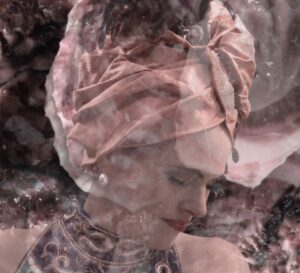
The most important thing for me is that I can develop my imagination and try things out. I don't want to compromise on that. Just as I trust the other two in their artistic decisions, they have to do the same with me. We complement each other. It's a really great constellation!
But you are not only responsible for the design, you also prepare something else.
Yes, indeed! Sarah has chosen a habanera for the next video. A dance, in other words. As I was a dancer for a very long time and it's always been an important part of my life, I take over the movement for this song. But we're not showing any dance choreography, it's all been done before. We want to change the perspective, create something completely new! So I came up with the idea of focusing on unusual body parts in front of the camera. For example, I provide my own elbows for this ... and Robert will use his imagination to create something new.
It can then be seen in the Klári 2 project. We are currently preparing the performance.
On what models is this work based?
It wouldn't suit me to work according to models. The basis is solely my imagination and my connection to music, dance and colors.
Do you have a goal with your work in the Klári projects?
We all have very different goals! Sarah wants to give people something with her voice, open their consciousness to a different level, I want to let off steam with my creativity.
And what does Robert want?
No idea! You'll have to ask him yourself!
I will! What project do you want to tackle next?
I'm not going to tell you that! It has to stay a bit exciting!
Dann danke ich bis hierher und freue mich aufs nächste Mal!
Klári 1
Klári - Suite
Chamber Concert For Voice, Piano. Video
& flute
Music
Voice, Piano
5 Songs op. 15
1. A vágyak éjele
(Night of Desire)
2. Szines álomban
(In a colourful dream)
3. Nyár
(Summer)
4. Itt lent a völgyben
(Down in the valley)
5. Az én szerelmem
(My love)
Piano:
Outdoors No. 4
Sounds of the night
Piano Solo:
Piano Étude Nr. 2
Sequences
Voice, piano, flute:
Shéhérazade
Nr. 1 Asie
Nr. 2 The Magic Flute
Voice Solo:
Gorech’! Gorech’!
(Bitterness! Bitterness!)
Flute Solo:
8 aşa-zise studii din traista fluieraşului călător
(8 etudes from the satchel of the wandering minstrel)
Musicians
.Piano
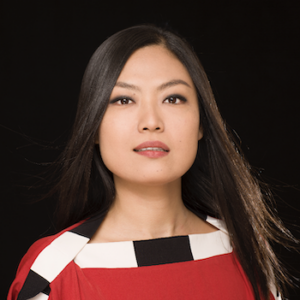 Her brilliant CD debut with works by Chin, Boulez, Ligeti and Messiaen won the "Coup de Coeur" of the Académie Charles Cros in France and her most recent Scriabin album was nominated for the Preis der Deutschen Schallplattenkritik and the In- ternational Classical Music Awards.
Her brilliant CD debut with works by Chin, Boulez, Ligeti and Messiaen won the "Coup de Coeur" of the Académie Charles Cros in France and her most recent Scriabin album was nominated for the Preis der Deutschen Schallplattenkritik and the In- ternational Classical Music Awards.
She has worked with composers such as Pierre Boulez, Unsuk Chin, conductors such as Kent Nagano, Steven Sloane, orchestras/ensembles such as the Philharmonic State Orchestra Hamburg, the Bochum Symphony Orchestra, the MDR Symphony Orchestra, the Staatskapelle Halle and the 1B1 Ensemble and has developed chamber music projects with Jörg Widmann, Jan Bjøranger, Eszter Haffner, Lars Anders Tomter and Torleif Thedéen, among others.
Yejin Gil has performed at the Festspiele Mecklenburg-Vorpommern, the Thüringer Bachwochen, the Klavier-Festival Ruhr, the International Piano Festival La Roque d'Anthéron and has given concerts at the Grand Théâtre de Genève, the Essen Philharmonie, the Salle Cortot, the Weimarhalle and the Konzerthaus Berlin. In addition to her artistic work, she devotes herself to pedagogical activities and regularly gives semina- res and master classes in the USA, Germany, England, Norway, France and Italy. She is also active as a juror at international competitions.
.voice .concept

The musical training of Berlin-born Sarah van der Kemp is extraordinarily broad: Musicology and piano are part of it, but singing is most important to her. She studied at the Hanns Eisler Academy of Music in Berlin with the grande dame of her field: Professor Julia Varady. She holds a scholarship from the Richard Wagner Society and has also attended masterclasses with the most renowned greats of our time, such as Peter Konwitschny, Thomas Quasthoff and Rudolf Piernay. However, her closest collaboration was with Dietrich Fischer-Dieskau, with whom she developed a broad repertoire including works by Johannes Brahms, Franz Schubert, Hugo Wolf and the entire song repertoire of Gustav Mahler.
In her fixed engagements as a solo mezzo-soprano at the Deutsche Oper Berlin and the Staatstheater Schwerin, Sarah van der Kemp Kemp sang many of the most important roles in her field:Duke Bluebeard's Castle), Composer (Ariadne on Naxos), Rosina (Barbiere di Siviglia), Hänsel (Hänsel and Gretel), Carmen (Carmen), Fox (The Cunning Little Vixen), Eboli (Don Carlo), Sieglinde (Valkyrie) und viele mehr.
Further engagements have taken Sarah van der Kemp to the Shenzhen Philharmonic Orchestra in China, the Dresden Philharmonic, the Berlin State Opera, the Konzerthausorchester Berlin, the Festival d'Avignon, the Festival de Radio France in Montpellier, the Philharmonie Baden Baden and many other international festivals.
In concert, her special passion is the interpretation of orchestral songs. Her repertoire includes songs by Mahler, Wagner, Berlioz, Berg, de Falla and others.
Her own projects and conceptions broaden and deepen the singer's expressive spectrum - she has developed concert series and individual events in various dimensions and constellations, in the recent past for example a juxtaposition of Mahler's Song of the Earth with commissioned works for solo instruments by Peter Eötvös, Toshio Hosokawa and Nathan Currier.

Robert Pflanz lives in Berlin and has his studio there.
Equipped with cameras and laptops, however, he works always and everywhere and sees himself as a hunter of the visual, whether concert, opera, dance, theatre or installation.
Robert, born and raised in the Ruhr area, began studying architecture there, at the same time gaining his first experience in the field of theatre design, and then went to Berlin to complete his main studies, first at the Weissensee School of Art, then at the University of the Arts (now the UdK). As a guest student at the Free University of Berlin, he intensively studied philosophical aspects of design. Finally, he completed a master's degree in stage design at the TU-Berlin.
As a central, highly paradoxical theme of his stage design, Robert Pflanz always states that he wants to make the world and worlds beside or behind the physical physically tangible.
On the other hand, Pflanz is a precise theatre practitioner who is also enthusiastic about clear structuring, the joining of elements. He experiences the artistic process as an essential part of the result.
In addition to his many years of experience as a freelance stage and costume designer, his focus since 2004 has been on video art.
He has worked at renowned theatres, opera houses and concert halls such as the Staatstheater Schwerin, the Komische Oper Berlin, the Staatsoper Unter den Linden, the Theater Schloss Maßbach, the Opernhaus Kiel, the Deutsche Oper Berlin, the Bad Hersfelder Festspiele, the Palacio de Bellas Artes in Mexico City, the Teatro Juárez in Guanajuato, the Staatstheater Cottbus, the Stadttheater Fürth, the Hamburg State Opera, the Michailowski Theatre in St. Petersburg, the Bavarian State Opera, the Mozarteum Foundation Salzburg, the Anhaltisches Theater Dessau, the Philharmonie Luxembourg, and many others. Petersburg, the Bavarian State Opera, the Mozarteum Foundation Salzburg, the Anhaltisches Theater Dessau, Philharmonie Luxembourg, and many more.
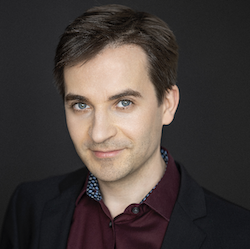
Aaron Dan tours internationally as a soloist, composer, chamber musician and presenter; he is the winner of several competitions, including the flute competition The Winner of Belgrade, 2005. In 2013, the ensemble he co-founded, Berlin Counterpoint, was awarded the Usedom Music Prize.
Aaron Dan's extensive compositional oeuvre includes dozens of new arrangements and compositions for his ensembles, many pieces for music theatre, orchestral works, choir and chamber music as well as more and more works for flute and loop station. In 2021 he created the sound installation BABEL for 40 loudspeakers (premiere Kunstmuseum Reutlingen). The Hungarian version of his children's opera The Little Prince will premiere in the spring of 2023 at the Hungarian State Opera in Cluj-Napoca, the city of his birth.
Aaron Dan lives in Berlin with his family.
For the concert program KLÁRI-SUITE for voice, piano and video, the Villa Elisabeth in Berlin was transformed into a meeting place for the arts.
The term "suite" can be understood not only as the musical genre concept of a sequence of character pieces, but also - analogous to the suite of the same name - as the sequence of sonic spaces to be experienced. In the video projection, another space opens up that adds an independent contribution to the interpretation of the music.
Programmatically, Béla Bartók's Five songs op. 15 (Klári-Songs) become the nucleus of an exploration of the entire range of passion between creative and destructive, intoxicating and ecstatic power.
Béla Bartók's Five Songs op. 15 (Klári-Songs) confront us with all the highs and lows of a young woman's intoxicating longings for love. In the posthumously published first edition by his son Peter Bartók, this cycle ends with the song Itt lent a völgyben (Down in the valley), the only song marked by hopelessness, loneliness and resignation. This sequence of songs tells a love story that ends in failure.
Bartók himself had laid down a different order in his manuscript, which convinced Sarah van der Kemp far more and inspired the KLÁRI SUITE project:
Bartók emphasises the cyclical change of emotional states. The Klári-Songs begin in the dark of night with the song A vágyak éjjele (Night of Desire), which describes the longing for love through the unsteady ups and downs of passionate emotions and erotic dreams. All five songs are assigned to times of day. Songs two to five, moreover, are also seasons, with temperature and weather conditions being related to the feelings of longing for love. Similar to Bartók's opera one-act and relationship drama Duke Bluebeard's Castle the song cycle begins in darkness and has its brightest and hottest (in the opera, most dramatic) climax at the dividing point of the golden section. (Song No. 3 Summer: „Offenen Mundes trink‘ ich die Sonnenfluten, der flammende Himmel stürzt auf mich herab!“) In the opera, the circle is closed by the return to darkness, the relationship has failed. In the In five songs, op. 15 reihen sich die facettenreich dargestellten Liebesgefühle in das Werden und Vergehen der Natur ein. Bartók beendet den Zyklus mit dem Verklingen des Klaviernachspiels bei gehaltenem Pedal im „The rapture of delight!“
Bartók's interest in the connections between mathematics and nature is reflected in his music. He liked to use the proportions of the golden section or the Fibonacci number sequence. The complete programme of the KLÁRI SUITE now also follows these principles of proportion. Based on the order in Bartók's manuscript and cyclical connecting points in terms of content, the Klári songs are heard in a new order that deviates from the publisher's usual counting - accompanied by the video with a black-and-white, blurred world of mist. This is followed by three solos that present the artistic media as individual elements: First for piano Unsuk Chin's Etude No. 2 Sequences, then Peter Eötvös' bitter Goretsch! Goretsch! for solo mezzo-soprano. Finally, the increasingly colourful and insane video solo leads into two songs from Shéhérazade, Ravel's settings of texts by Tristan Klingsor, exuberant with exotic sensuality, eroticism and violence. In the works originally conceived as orchestral songs, a delightful effect is created by the rapturously colourful video projections. In the second piece, La flûte enchantée, special guest Aaron Dan takes over the part of the solo flute before the programme is reflected in a concluding cadenza, releasing the audience into their own dreams with Bartók's Sounds of the Night.
The overall dramaturgy of the programme elevates formal peculiarities from Bartók's composition to a guiding principle: the piece complexes with the circumferences 8/5/3/2/1 follow the reverse Fibonacci sequence, emotional lows and climaxes are heard at the dividing point of the Klári songs and the entire suite respectively, corresponding to the golden ratio. These proportions also determine the colour and lighting direction. The programme as a whole expands from the formal density of the Klári songs to the fantastic expanse of Shéhérazade and the finale.
Klári 2
Reflections
Chamber Concert For Voice, Piano, Video,
Flute & Cello
Donation
see interview
Voice, Piano
5 songs op. 16
Autumn Songs of the Dead
Voice, Piano
5 commissioned works
Voice, flute, cello, piano:
3 songs
Chansons Madécasses
